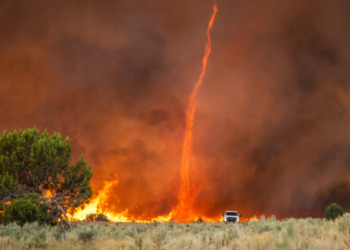On 2 May 2023, Pauline Stensgar, of Keller, Washington State, died at the age of 96. Her language died with her.
The Spokesman-Review in Spokane reported she was the last fluent speaker of the n̓xaʔm̓xčín̓ (pronounced ‘in-ha-um-cheen’) language.
It was a language that had been spoken by some groups of Native Americans in the Washington State region.
Thanks to Stensgar’s love for her language, it is not completely lost to us.
Together with Christopher Parkin, the principal of the Salish School of Spokane, Stensgar had created six textbooks and more than 100 recordings of the language.
Anyone interested can still learn n̓xaʔm̓xčín̓.
But for many extinct languages, we’re not so lucky. They can be lost to us forever.
And in the parts of the world richest in languages, environmental disaster is forcing the displacement of millions of people — a major trigger of language extinction.
Language is uniquely human, our cognitive capacities on full display.
Each of the more than 7,000 living languages in the world today encodes the worldview, history and knowledge of its speakers.
Many endangered languages — those that are rapidly losing speakers — hold vital knowledge about local plants, including unique knowledge on these plants’ medicinal uses.
These languages also hold knowledge on animals and how to live sustainably in the local environment.
This means that we not only lose languages, we also lose knowledge that can help us live better, healthier and more sustainably.
We lose languages when speakers no longer pass these languages on to their children. This often happens when speakers of minority languages switch to languages that are economically more advantageous.
Migration plays a large role in this. For example, most second-generation immigrants to the US speak English fluently, but not their parents’ languages.
English is economically and culturally beneficial to them, but their parents’ languages are not.
A look at where the most Indigenous languages are endangered reveals the impact of previous migrations.
In 2021, 98% of Indigenous languages in the US and 89% of Indigenous languages in Australia were endangered.
Both countries have a colonial history and have seen mass immigration from Europe in previous centuries.
These earlier migrations affect Indigenous languages to this day — we continue losing languages in these countries because speakers no longer pass them on to future generations and switch to English instead.
So, today’s migration will likely be tomorrow’s language loss.
Forced migration plays a large role in current migration patterns. According to the Global Trends Report 2022, more than 108 million people were forcibly displaced in 2022. About 61 million of them were displaced within their own countries.
More than half of those internally displaced had to leave their homes because of environmental disasters, such as floods and storms. The remaining people were internally displaced by conflict and violence.
Related Articles: Indigenous Languages and Ecocide: The Legacy of Western Colonialism Re-examined | The Effects of Globalisation on Languages and Cultural Diversity
Almost all internal displacement in Europe and Central Asia in 2022 was due to conflict and violence.
In contrast, almost all internal displacement in South Asia, East Asia and the Pacific was caused by weather-related disasters, such as floods and storms.
Some of the most linguistically diverse countries are in South Asia, East Asia and the Pacific, those regions particularly affected by environmental disasters.
Papua New Guinea has at least nine million inhabitants. Between them they speak 839 different languages with 313 of those languages endangered.
The 300,000 inhabitants of Vanuatu speak 108 different languages, of which more than half are endangered.
Indonesia has another 704 living languages, India has 424, and the Philippines has 175. Almost half of the languages spoken in these three countries are endangered.
More than one third of the languages considered endangered are spoken in those five countries alone.
The large numbers of already endangered languages combined with the large numbers of people displaced by environmental disasters make South Asia, East Asia and the Pacific particularly vulnerable to future language loss.
Many of these endangered languages are spoken in a small geographic area and have only a few hundred speakers left.
If speakers of those languages leave their small communities and scatter — for whatever reasons — it becomes less likely that they will pass on these languages to future generations.
Outside their small communities, these languages are likely to have little economic and cultural value.
The problem with forced migration is that people lose their community.
So, lots of the things that people propose to preserve languages — like ensuring communities remain together, have a viable environment to live in and ways of making a living — do not necessarily apply here.
There are many reasons for language loss, and migration is only one part of the puzzle.
But in those parts of the world where we find many of the endangered languages, environmental disasters are a major driving force of migration.
And this forced migration — and subsequent threat to languages — has the potential to accelerate.
— —
This article was originally published by 360info™.
Editor’s Note: The opinions expressed here by the authors are their own, not those of Impakter.com — In the Featured Photo: The climate crisis can create forced migration that significantly reduces the number of languages in the world. Featured Photo Credit: John Englart.










